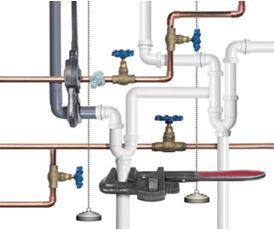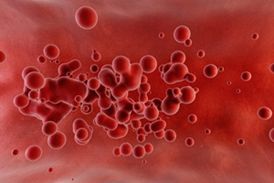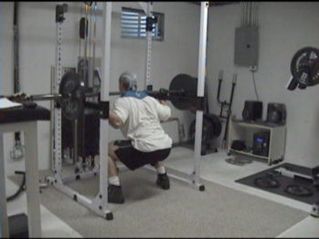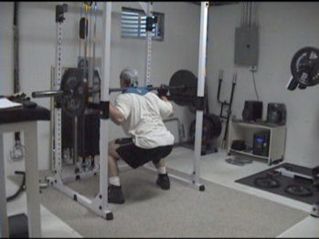
When it comes right down it, there are real physiological reasons why some people don’t gain muscle quickly and some do..and these reasons will have a HUGE effect on how difficult it will be for you to build a bigger butt.
There are some factors you can’t do anything about (e.g. genetics, predominant muscle-fibers types, and basic hormonal make-up) but there are MANY factors you can focus on in your training that can actually change your base physiology to make it more favorable to muscle growth.
THOSE are the factors we’re going to focus on and train for in this program.
I like to compare it to building a house...

You’re going to be able to build a bigger, better house (i.e. muscle mass) when the walls and beams are thicker and stronger (bones and connective tissue), the plumbing is better (your circulatory system) and your electrical system is more efficient (your nervous system).
This training is going to address these base physiological factors and change them for the better. It’s going to make it easier for you to build muscle, no matter what your level of ability to gain muscle mass is currently at!
I call it "Structural Training" and it’s going to build your muscle "base"...the plumbing, the electric system and the structure that’s going help you make the best use of the actual "building" training you’ll be doing during the other phases of the program.
This training is not about building muscle directly...it’s about SETTING THE STAGE for faster glute building in the other programs. This is the training that’s going to PREPARE your butt for maximum growth!
You’ll do 3 training sessions this week for the glutes, with a day off in between, e.g. Monday, Wednesday, Friday. You can work other bodyparts after you’re done with the glute training (it usually won’t take more than 20 minutes or so to get through) or you can do them on your "rest" days from glute training. Definitely do this glute training FIRST on your training days, though. You want to hit that when you’re freshest.
You can perform this program for one week, then move to one of the other programs or you can do it for 2 to 3 weeks in a row
(maximum) before going to one of the other programs.
Another option is to do one week of this training then 3 weeks of another program, then one more week of this training, then 3 weeks of other glute training, etc. basically inserting this program in with the other training.
The first training day is going to entail moderate weight with fairly high reps (20+ reps per set). You’ll be doing these with FAST speed, which will help fire up the nervous system along with helping you to squeeze more reps out.
This will also force a LOT of blood into the glutes, helping increase microcirculation to those muscles. Microcirculation is a CRITICAL and often-ignored factor in muscle building...it’s a name for the tiny blood vessels (capillaries) where nutrient and oxygen exchange take place.
If you have poor microcirculation (does your butt get cold easily at night? That can be an indicator :), it could be a BIG reason why you’re having trouble building your glutes. They’re just not getting their share of nutrients and oxygen to help them grow and function.
THIS training is going to help improve that. Because when you force a lot of blood into a muscle, it gets overloaded and the blood basically FORCES it’s way through, creating new capillaries on a cellular level. This means more nutrients and oxygen to the muscle fibers.
Ideally, for this training you’ll want to use a weight you would normally use for about 12 to 15 reps (depending on the exercise) and get at least 20+. You’re just going to do one set of that exercise (and only a few exercises in total), so there will be no reason to hold back.
The idea is to hammer out as many reps as you possibly can and do them FAST.
Then you’ll rest 15 to 20 seconds, to flush out some of the lactic acid so that the burn doesn’t hold you back on the NEXT part...stretch-focused sets.
You’ll be immediately doing a set of 4 to 6 reps on a stretch-focused exercise for that muscle group, e.g. elevated front foot lunges. Hold that bottom stretch position for at least 5 seconds on every rep. You’ll want to use a fairly light weight (or even no weight at all!) on these as the goal is massive STRETCH not build your ego.
The idea behind this is to use the first set to fill the blood with muscle and then immediately use this stretch set to stretch fascia (the connective tissue "pillowcase" that surrounds the muscles). This fascia is critical for keeping the muscle contained but it’s also tight enough to prevent the muscle from growing.
Think of it like a pair of tight jeans. When you get them out the laundry, you put them on then to loosen them up, you squat down a few times to stretch them out a bit. THAT is what we’re trying to do with the stretch exercises here...stretch out those tight jeans.
On Day 3 of the training, you’ll be doing almost the same thing. The only difference is that the first exercise is going to be 100 reps per set. You’ll use very light weight and try and get 100 reps straight through in one set (if you can’t 100 reps, I’ll tell you how to work the training to compensate).
This very high rep training is ideal for building type 1 muscle fibers (slow-twitch endurance fibers) but that isn’t the major goal...the major goal is increasing microcirculation to the muscles.

As I mentioned above, the tiny blood vessels in your body where nutrient and oxygen exchange take place are known as capillaries. Our goal with 100 rep training is to increase the capillary density in your muscles so more nutrients and oxygen can reach the muscle fibers.
One of the major things that holds back muscle development is lack of nutrients reaching the muscles. Think about the muscle groups you have the hardest time developing. They’re the ones that are the hardest to get a pump in, right?
That means poor circulation and THAT is what we’re going to fix with this style of training.
So you’ll aim for 100 straight-through reps here. If you can’t get to 100 all at once, get as many as you can then stop, set down the weight and take 10 seconds rest. Now pick up the weight and get as many more reps as you can. Keep going until you reach 100 total reps. The short breaks will allow you clear a bit of lactic acid while regenerating a bit of energy to help keep going.
It’s important to keep track of how much weight you’re using and how many reps you got because the next time you do the 100 rep sets, you’ll have two choices.
1. If you got 100 reps straight-through on that exercise, increase the weight by the smallest amount possible and use that this time.
2. If you didn’t get 100 reps straight-through, repeat with the same weight. When you are able to get 100 reps, THEN you can increase the weight. You have to earn it.
You’re also going to be doing the stretch-focused sets immediately after the 100 rep sets (15 to 20 seconds rest between the two), to get that fascial stretching going again.
On a side note, this type of training can make you VERY sore. I’d recommend taking 500 mg of Vitamin C a little before training. It can actually really help decrease soreness.
Partial training is going to target the connective tissue and structure of your body as well as the nervous system and the microcirculation that I talked about above (because of the high rep range).
You’re going to be working in a very short range of motion in a glute exercise. This might be either in the top of bottom portion of the range, depending on which exercise you’re using. It’ll be the bottom if THAT is the valuable part of the exercise (like most squatting and lunging movements)...top, if it’s a contracted-position exercise like glute barbell extensions.
You’ll be going for HIGH reps with this...at least 30+ per set. Focusing on the best part of the range of motion of an exercise is really going to have a big impact on the glutes and also on your strength levels for performing the FULL exercises later on.
As an example, here’s what bottom squat partials looks like (the pictures look almost exactly the same because the range of motion is so small!):


When you’re doing high-rep partials, you can use a fairly fast movement, but don’t bounce (especially with squats). You want to keep the tension on the glutes the entire time. It can be fast but it should be deliberate.
Use a moderate weight for these...we’re going for high reps of at least 30+ reps per set in that "money" range of motion for each exercise.